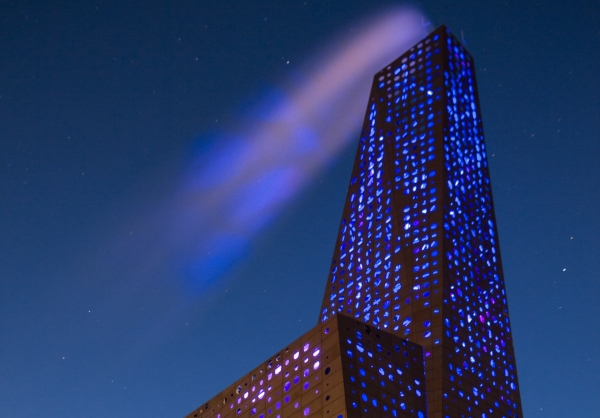Media Architecture Biennale Awards 2014
For the second time, Media Architecture Biennale Awards were given will to outstanding projects at the intersection of architecture, media and interaction design. This happened at an award ceremony at Aarhus City Hall on November 21, 2014.
Winner Animated Architecture: Energy Tower Fa├¦ade Lighting (Denmark)
The fa├¦ade is designed by Erick van Egeraat and consists of two layers: The inner layer is the ŌĆśskinŌĆÖ, providing the actual climatic barrier and allowing the second layer to be treated more freely. This second layer is made of raw umber-coloured aluminium plates with an irregular pattern of laser cut circular holes. The plates are treated to give them the desired colour and patina at day time. At night, the programmable lighting, installed between the two facades, gives the building an additional metaphor, and lights up surrounding Roskilde as a new and already popular landmark. The architectural concept of the fa├¦ade lighting designed by Erick van Egeraat was identified and implemented by Gunver Hansen with the lighting solution, provided by Martin Professional.
Winner Spatial Media Art: Light Barrier (Russia and South Korea)
Kimchi and Chips create phantoms of light in the air, crossing millions of calibrated beams with their work Light Barrier. This light installation creates floating graphic objects which animate through space as they do through time. ŌĆØThey tell a story only using light. ThatŌĆÖs very interesting,ŌĆØ Dr. Gernot Tscherteu said in when explaining why this project won a category with many strong submission. Light Barrier was co-commissioned by FutureEverything and The British Council. It premiered at New Media Night Festival in Nikola-Lenivets, 2014.
Winner Money Architecture (Denmark): Dia Lights
In May 2013, The Confederation of Danish Industry (DI) moved back into their rebuilt headquarters in the heart of Copenhagen. The extensive architectural task has been carried out by Transform who has redesigned the physical manifestation of the DI. The different designs have been turned into generic light plugins that fit into KollisionŌĆÖs player-system. These light plugins can be controlled by the graphical department at DI who can tweak and modify parameters like speed, colors, and direction creating thousands of different expressions. All these light designs can be previewed in the 3D player system displaying each of the +80000 LEDs. The system holds potentials for adding interactive components, allowing the citizens to interact directly with the fa├¦ade.
Winner Participatory Architecture (Kenya): digitalMatatus
Technology is transforming the way we relate to transit. Digital Matatus is a key player in the movement to make transportation in the developing world more efficient, and open. A collaborative project of the University of Nairobi, Columbia UniversityŌĆÖs Center for Sustainable Urban Development, MITŌĆÖs Civic Data Design Lab, and Groupshot. Digital Matatus has developed and deployed purpose-built mobile phone apps to more efficiently collect location data of NairobiŌĆÖs buses. They have used the information gathered through this crowd sourcing method to produce standardized bus routes for the city, now assembled together and made available in a full city-wide bus map released to the public in January of 2014.
Winner Trends and Prototypes (Russia) MegaFaces
MegaFaces Pavilion is a structure incorporating the worldŌĆÖs first large scale actuated LED screen / kinetic facade conceived by Asif Khan and engineered by iart at the Sochi 2014 Winter Olympics for MegaFon. Formed by 11.000 actuators, the kinetic facade of MegaFaces is able to tranform in three dimensions to create visitorsŌĆÖ faces in Mount Rushmore-style monumental scale. Facial impressions are relayed to the facade from 3D photo booths within the building and across Russia. A queuing system manages the data and visitor names are displayed on screens indicating the time their face will appear.
